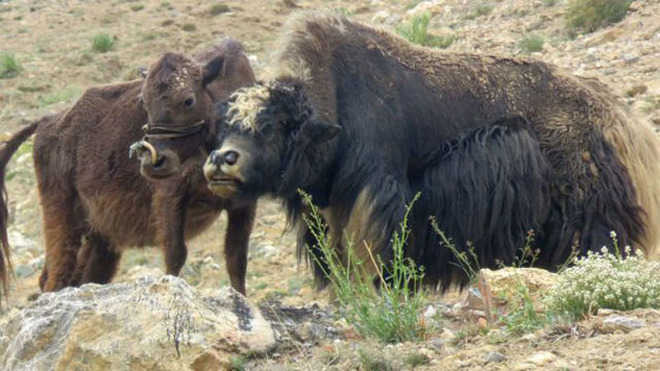Kirti Dua
Spiti is one of the most beautiful places in the country. Literally meaning, “The middle land” (between India and Tibet), this place is blessed with diverse and unique domestic and wild animals.
Yak
Among the most commonly found animals here are the yaks. Decorated yaks, meant for safari, can be found at various places like Kufri, near Shimla but we had the first glimpse of this beautiful wild beast at Kibber village, 25 km from Kaza, on our way to Gue monastery in Spiti. Yak is an important animal of the cold desert region and is kept for milk, meat, wool and also used as a pack animal. Wild yaks are generally dark, blackish to brown in colour whereas domestic yaks can be quite variable in colour, often having patches of rusty brown and cream. Yaks are heavily built and have long fur that hangs down lower than the belly. Yak and their manure have little to no detectable odour. Yak’s wool is also odour-resistant. Its long hair is made into fly whisks, ropes and is woven into a rough cloth meant to cover tents. As compared to cattle, yak’s lungs and heart are larger and also has greater oxygen carrying capacity in blood. Its long fur, thick layer of sub-cutaneous fat and lack of functional sweat glands make these animals well-adapted to these climatic changes. Whenever, these animals are brought to lower heights or the temperature exceeds 15º C, they suffer from heat exhaustion.
People of this area are using age-old wisdom to improve the adaptability of livestock in this area. They have crossbred domestic cattle with yak. The male offspring is called Dzo and is infertile but are very efficient draught animal in the harsh climate and difficult terrain. Dzomo, the female offspring, is fertile. They are not a high yielder of milk like cow but certainly capable of surviving in severe winters. Yak’s milk is an important ingredient of butter tea. This milk is also processed to make cheese called chhurpi, which is frequently used in thukpa.
Horses and donkeys
Grazing horses in the backdrop of snow covered mountains at Kibber village and at Losar village just before Kunjam pass is a sight to behold. The area is home to chhumurthi horses, the best and largest animal population is confined to approximately 15 villages of two panchayats in the Pin valley. This place is also known for Spiti donkeys, which are used for the transportation at high altitude area with a low-level of environmental oxygen. These animals can survive well in scarcity of feed and fodder during harsh winter months when the area is completely snowbound.
Sheep and goats
Many herds of sheep and goat can be seen grazing in the valley. These herds move to higher pastures during summer whereas during winter they migrate to the lower areas. In the upper regions of the Spiti valley, there are some pockets where pashmina goats are reared. The body of pashmina goats is covered with silky hair about 10-12 cm long, beneath which is a fur like undercoat of great fineness and warmth, called pashmina. It is used to make famous pashmina shawls.
Snow leopard
One of the most beautiful animals of this area is the snow leopard, which is also nominated as the state animal of Himachal Pradesh. In the Kibber wildlife sanctuary, there are about 30 snow leopards. The most favoured prey of snow leopard is the blue sheep. Besides this, valley has foxes, Himalayan brown bear and musk deer which we missed this time. Maybe next time.
Blue sheep
We were twice lucky to come across blue sheep herd in the valley. Blue sheep, also known as bharal, has a bluish sheen in the coat. They are wild animals found in the high altitude of the Himalayas. Both male and female have horns, which are ridged on the upper surface in males whereas short and straight in females. These animals don’t have any cover in the environment but has an excellent camouflage. Many Buddhist monasteries protect the bharal found around them, but lately, issues of crop damage caused by bharal have started to arise.
Unlock Exclusive Insights with The Tribune Premium
Take your experience further with Premium access.
Thought-provoking Opinions, Expert Analysis, In-depth Insights and other Member Only Benefits
Already a Member? Sign In Now










